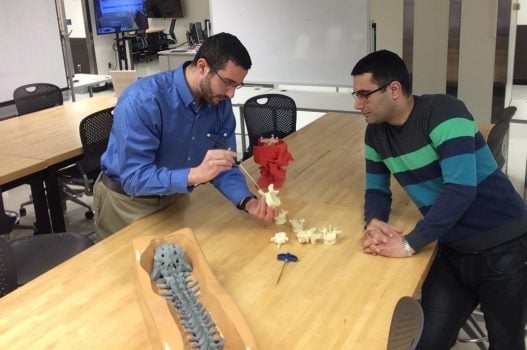Johns Hopkins launches new one-year biomedical design program for med students

The Johns Hopkins Center for Bioengineering Innovation and Design, which specializes in medical device design, has launched a one-year gap program with funding for medical students studying at the Johns Hopkins University School of Medicine.
The program builds on the success of CBID’s David E. Swirnow Master of Science program stipend, partial tuition support, and research fund allowance specifically for medical students. The new gap year program is open to qualifying medical students from The Johns Hopkins Hospital for the 2017-2018 academic year, and is expected to expand to applicants from other schools in future.
“This is the first program of its kind, offering a gap-year research training experience for medical students to learn how the tools they will be using to help patients are designed and developed,” said Youseph Yazdi, CBID’s executive director. “These students will gain hands-on experience designing health care solutions for both advanced and low-resource healthcare systems. They will also enrich the program for our other students, providing insights from their medical school training.”
The program is offered in partnership with the Johns Hopkins Institute for Clinical and Translational Research. Funding is provided in part by the institute through the TL1 grant Predoctoral Clinical Research Training Program, which provides medical students with additional training and mentorship in clinical and translational research.
The program had a trial run this year, when medical student David Gullotti joined the CBID MSE gap year program between his third and fourth years of medical school. His experiences working with other CBID students, and their experiences working with him, were so successful that a decision was made to expand and formalize the initiative. In the past, two medical doctors, both plastic surgery residents, graduated from the program.
Gullotti praised the program’s condensed timeframe, and says he gained “incredibly valuable” knowledge and experience.
“As demanding as medicine is, I expect it would be challenging down the line to learn how to bring a medical device from the conception of an idea to market,” he said. “Entering residency with the knowledge gained from this program will put a great deal of wind to my sails in order to more quickly and effectively impact patients through the design of medical devices.
“Many of my peers with technical backgrounds and an interest in having a wider impact on health care will find the CBID MSE to be a good complement to the MD curriculum.”
CBID was established in 2006 and is located within JHU’s Department of Biomedical Engineering, which is ranked No. 1 in the nation by U.S. News and World Report. The center manages the BME Design Teams program, and each year CBID researchers educate more than 100 students, oversee roughly 25 design-team prototypes, and work with more than 40 clinicians, mostly at the Johns Hopkins Medical Institutions.
The CBID MSE program, which launched in 2009, begins each June with two months of clinical rotations in the Johns Hopkins Hospital. Students then visit developing countries such as India, Nepal, and Tanzania to gain first-hand knowledge of international health needs. Over the course of the year, students work with clinicians, physicians, engineers, and entrepreneurs to develop two device prototypes—one for the U.S. market and one for the developing world market. These prototypes are debuted in the spring at the annual BME Design Day event.
In addition to the value of the CBID MSE program, med students taking advantage of this new gap year opportunity will receive training to formulate a research question, submit it for presentation at a national conference, and submit it for publication. The Institute for Clinical and Translational Research’s involvement gives students the opportunity to learn about and take part in the early steps in translation—moving their discoveries into medical practice and meaningful health outcomes.
“To have the opportunity to learn through a formalized and condensed time period like CBID, rather than learning through trial and error on your own is very valuable,” Gullotti said, “because you have the support of people who have gone through the process over and over again.”
According to Yazdi, gap years are becoming increasingly common. A break between a student’s third and fourth years offers the opportunity for valuable additional experience, whether in research, a sponsored fellowship, or a degree-seeking program such as the CBID program.
“Future physicians like David, who understand how the tools around them are designed, developed, and reach the market,” Yazdi said, “will be natural leaders and innovators in medicine.”
